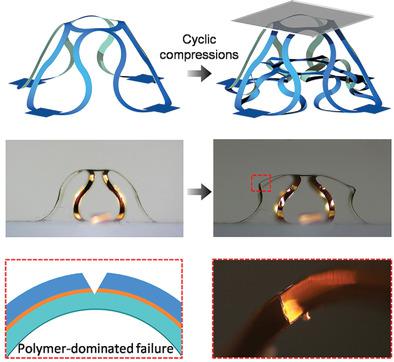当前位置:
X-MOL 学术
›
Adv. Mater.
›
论文详情
Our official English website, www.x-mol.net, welcomes your feedback! (Note: you will need to create a separate account there.)
An Anti-Fatigue Design Strategy for 3D Ribbon-Shaped Flexible Electronics
Advanced Materials ( IF 29.4 ) Pub Date : 2021-08-02 , DOI: 10.1002/adma.202102684 Xu Cheng 1, 2 , Fan Zhang 1, 2 , Renheng Bo 1, 2 , Zhangming Shen 1, 2 , Wenbo Pang 1, 2 , Tianqi Jin 1, 2 , Honglie Song 1, 2 , Zhaoguo Xue 1, 2 , Yihui Zhang 1, 2
Advanced Materials ( IF 29.4 ) Pub Date : 2021-08-02 , DOI: 10.1002/adma.202102684 Xu Cheng 1, 2 , Fan Zhang 1, 2 , Renheng Bo 1, 2 , Zhangming Shen 1, 2 , Wenbo Pang 1, 2 , Tianqi Jin 1, 2 , Honglie Song 1, 2 , Zhaoguo Xue 1, 2 , Yihui Zhang 1, 2
Affiliation

|
Three-dimensional (3D) flexible electronics represent an emerging area of intensive attention in recent years, owing to their broad-ranging applications in wearable electronics, flexible robots, tissue/cell scaffolds, among others. The widely adopted 3D conductive mesostructures in the functional device systems would inevitably undergo repetitive out-of-plane compressions during practical operations, and thus, anti-fatigue design strategies are of great significance to improve the reliability of 3D flexible electronics. Previous studies mainly focused on the fatigue failure behavior of planar ribbon-shaped geometries, while anti-fatigue design strategies and predictive failure criteria addressing 3D ribbon-shaped mesostructures are still lacking. This work demonstrates an anti-fatigue strategy to significantly prolong the fatigue life of 3D ribbon-shaped flexible electronics by switching the metal-dominated failure to desired polymer-dominated failure. Combined in situ measurements and computational studies allow the establishment of a failure criterion capable of accurately predicting fatigue lives under out-of-plane compressions, thereby providing useful guidelines for the design of anti-fatigue mesostructures with diverse 3D geometries. Two mechanically reliable 3D devices, including a resistance-type vibration sensor and a janus sensor capable of decoupled temperature measurements, serve as two demonstrative examples to highlight potential applications in long-term health monitoring and human-like robotic perception, respectively.
中文翻译:

3D 带状柔性电子产品的抗疲劳设计策略
三维(3D)柔性电子产品是近年来备受关注的新兴领域,因其在可穿戴电子产品、柔性机器人、组织/细胞支架等方面的广泛应用。功能器件系统中广泛采用的 3D 导电介孔结构在实际操作过程中不可避免地会经历重复的平面外压缩,因此抗疲劳设计策略对于提高 3D 柔性电子器件的可靠性具有重要意义。以前的研究主要集中在平面带状几何结构的疲劳失效行为上,而针对 3D 带状细观结构的抗疲劳设计策略和预测失效标准仍然缺乏。这项工作展示了一种抗疲劳策略,通过将金属为主的失效转换为所需的聚合物为主的失效,显着延长 3D 带状柔性电子设备的疲劳寿命。结合原位测量和计算研究,可以建立能够准确预测平面外压缩下的疲劳寿命的失效准则,从而为具有不同 3D 几何形状的抗疲劳细观结构的设计提供有用的指导。两个机械可靠的 3D 设备,包括一个电阻型振动传感器和一个能够解耦温度测量的 Janus 传感器,作为两个示范性示例,分别突出了长期健康监测和类人机器人感知的潜在应用。
更新日期:2021-09-14
中文翻译:

3D 带状柔性电子产品的抗疲劳设计策略
三维(3D)柔性电子产品是近年来备受关注的新兴领域,因其在可穿戴电子产品、柔性机器人、组织/细胞支架等方面的广泛应用。功能器件系统中广泛采用的 3D 导电介孔结构在实际操作过程中不可避免地会经历重复的平面外压缩,因此抗疲劳设计策略对于提高 3D 柔性电子器件的可靠性具有重要意义。以前的研究主要集中在平面带状几何结构的疲劳失效行为上,而针对 3D 带状细观结构的抗疲劳设计策略和预测失效标准仍然缺乏。这项工作展示了一种抗疲劳策略,通过将金属为主的失效转换为所需的聚合物为主的失效,显着延长 3D 带状柔性电子设备的疲劳寿命。结合原位测量和计算研究,可以建立能够准确预测平面外压缩下的疲劳寿命的失效准则,从而为具有不同 3D 几何形状的抗疲劳细观结构的设计提供有用的指导。两个机械可靠的 3D 设备,包括一个电阻型振动传感器和一个能够解耦温度测量的 Janus 传感器,作为两个示范性示例,分别突出了长期健康监测和类人机器人感知的潜在应用。



























 京公网安备 11010802027423号
京公网安备 11010802027423号